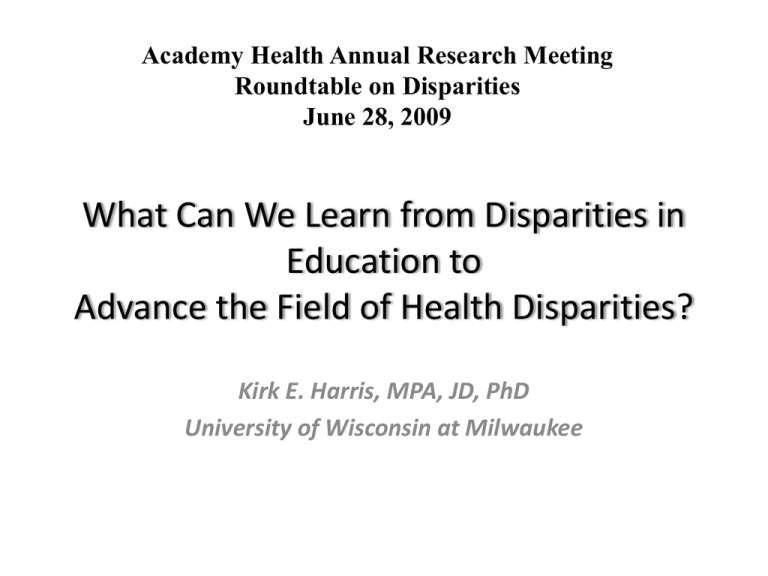What Can We Learn from Disparities in Education to
advertisement

Academy Health Annual Research Meeting Roundtable on Disparities June 28, 2009 What Can We Learn from Disparities in Education to Advance the Field of Health Disparities? Kirk E. Harris, MPA, JD, PhD University of Wisconsin at Milwaukee Structural Precursors to Disparities • For most individuals the most common entry point for access to health care is employment • Unemployment rates for African-Americans and Latinos are consistently higher than that of their white counterparts and in the case of African-Americans almost double the rate of their white counterparts • Growth in part-time, seasonal and temporary employment that typically carries no benefits Disparities in Education are also Structural • Urban school are typically highly segregated • Low student retention and graduation rates • Inequitable allocation of educational resources • Lack of effective institutional response to growing inequity Constructing New Vehicles for Delivery Charter School Model • Student centered pedagogy with a focus on customization – One size does not fits all – Values student, parent and community voices. – Recognize that the educational setting must be flexible and responsive to the emerging needs of the students, their parents and the community at large. – Connect and develop trust among students and their parents by making them a part of the decision-making . – Make information, materials and educational opportunities readily available to students and parents (ie., Resource Center). Take it to the People Student, Parent and Community Engagement and Leadership • Cultivate a working relationship built on a shared leadership model (surrender the position of expert). • Get to know and understand the issues that are most salient to the students, their parents and the community . • Be open to listening to the personal or community narrative. • Consider Home-visiting as a strategy to build stronger relationships by connecting with families in their own enviorment. Identify Under-Utilized Community Pathways Understanding the unique community assets (for example): • Fathers • Faith-based institutions • Schools • Civic Organizations Identify Under-Utilized Community Pathways Understanding the unique community assets (for example): • Fathers and Mothers as Leaders • Faith-based institutions • Schools • Civic Organizations QUESTIONS?











